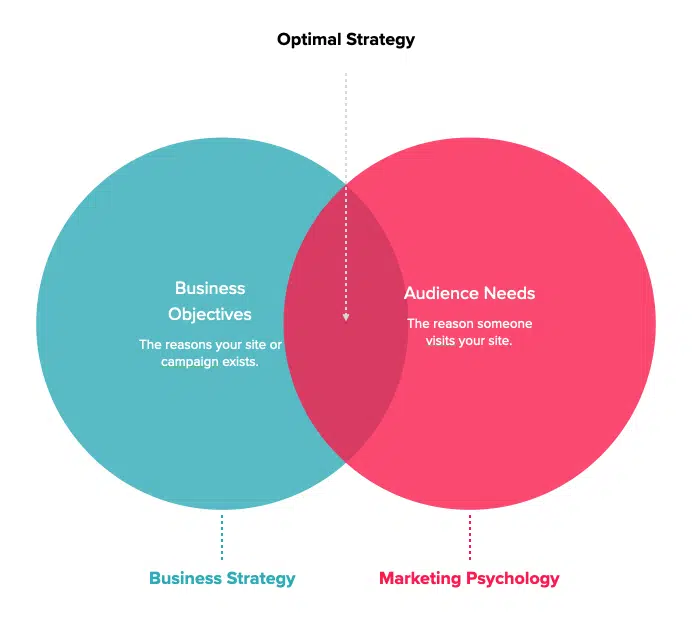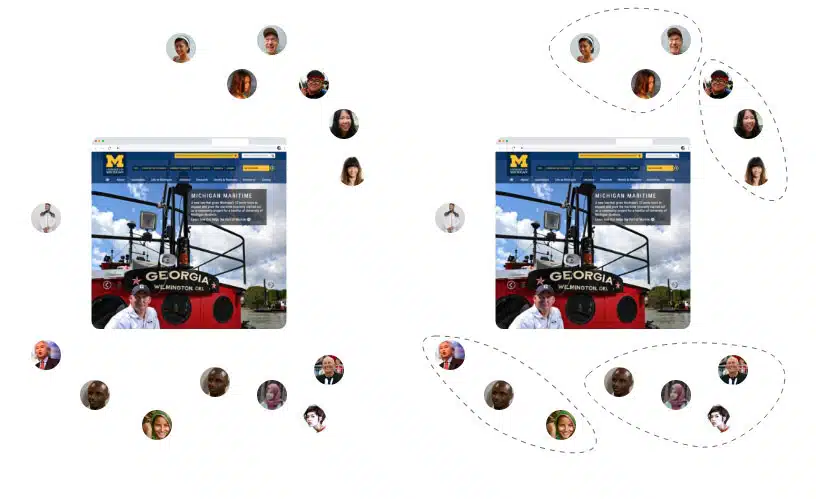- Digital and Design Strategy
- Digital Marketing
- Updated 08/13/2025
Transforming Tech with Digital Marketing: Gaining a Competitive Edge
Summarize this post
Digital marketing is an essential part of how today’s tech companies reach customers. A tailored digital marketing strategy can provide high value content to potential customers while also demonstrating the need and effectiveness of your offerings. This article dives into the importance of digital marketing for tech companies and the most important tactics and platforms to consider when creating your strategy.
Common Challenges in Marketing Tech Companies
Understanding the challenges associated with marketing technology companies can help you better tailor your strategy and anticipate potential roadblocks that may come your way throughout the buying cycle. Here are several potential issues that decision makers in the tech industry should be aware of when it comes to digital marketing.
- Complex Product Understanding: Tech products often involve complex features and benefits that can be difficult to convey succinctly to potential customers.
- Targeted Audience Needs: The audience for tech products usually consists of individuals with specific needs and substantial knowledge, often necessitating highly technical marketing material.
- Extended Sales Cycles: The decision-making process for purchasing tech products or services can be lengthy, as it often involves multiple stakeholders and significant financial investments.
- Intense Decision-Making: Buyers are usually thorough in their decision-making process, demanding comprehensive data and proof of value before making a final purchase.
- Differentiation Challenges: In a highly competitive market, differentiating your products or services from competitors can be tough, especially when many technologies offer similar features and functionalities.
- High Expectations for Information: Customers expect detailed and precise information tailored to their specific industry or needs.
Business Needs Discovery
As you dive into the digital marketing process for your business, it’s important to start by evaluating your specific needs and goals. This is where the business needs discovery comes into play. This phase involves a thorough deep dive into your product or service; marketers must fully grasp the features, benefits, and potential applications of your offering to understand how to create compelling marketing messages that resonate with the target audience. In addition, your team must align the marketing strategy with your company’s overall business objectives. For example, some newer companies may prioritize elements like brand awareness, while those launching targeted product launch campaigns may care more about actual sales and conversions.
Market Research
Market research is an essential part of developing digital marketing strategies for companies in any industry. But it’s especially important for those in the tech sector, with its rapidly changing trends and consumer demands. The market research phase can include several key steps and elements. Here are some of the most common tactics to consider.

- Industry Analysis: Examine current and emerging market trends and any technological advancements that are impacting the industry.
- Competitive Analysis: Identify key competitors within your market, evaluating their strengths and weaknesses to find gaps and opportunities within your marketing messages.
- Customer Insights: Conduct surveys, focus groups, and interviews to gather customer feedback, better understanding their preferences and tailoring your efforts to their buying behaviors and decision-making processes.
Digital Marketing Objectives
Before launching your digital marketing campaigns, it’s important to create clear objectives and SMART goals, which should be Specific, Measurable, Achievable, Relevant, and Time-bound. This clearly defined approach helps set precise targets like improving website traffic by a certain percentage, generating a specific number of leads, or achieving a set conversion rate within a defined period.

By establishing SMART goals, tech companies can create focused, effective marketing campaigns that are optimized for measurable success, allowing for adjustments based on real-time data and insights.
Segmentation, Targeting, and Positioning (STP)
Segmentation, Targeting, and Positioning (STP) are essential for improving relevance and efficiency within your marketing campaigns. Here’s a look at each element within this phase:
- Segmentation: This step involves dividing the potential market into distinct groups based on demographics, psychographics, behavioral patterns, and specific needs. This enables marketers to identify niches with particular characteristics and needs that align with the product’s offerings.
- Targeting: This follows segmentation, where the focus shifts to selecting the most valuable and relevant segments that promise the highest returns and align closely with the company’s strategic goals.
- Positioning: This final step, which is crucial for distinguishing a tech product in a competitive market, involves crafting a unique value proposition and messaging that clearly communicates the product’s distinct benefits and advantages for your specific target group.

Campaign Strategy
An effective campaign strategy for your tech company’s digital marketing strategy can include a tailored mix of several elements. Before diving in, it’s essential to understand the different options and the situations in which they can deliver the best possible results. Depending on your specific needs, your company may use several strategies, including the following or just a couple. Here are some specific tactics to consider as you shape your campaign strategy.
- Audience Education and Resources: Develop content that addresses common industry challenges and provides educational value to potential customers.
- Thought Leadership: Publish original articles and reports that project you and/or the company as an expert in your field.
- Product-Led Growth: Use demos, webinars, and feature-specific pages to showcase the product’s usability and efficiency.
- Free Trials or Freemium Tiers: Offer no-cost versions of the product, such as freemium models or free trials, to allow potential customers to try before they buy.
- Communities: Engage with existing online communities within your niche or create new ones focused on your offerings.
- Events: Host webinars and participate in or sponsor virtual conferences or meetups.
- Partnerships and Co-Marketing: Collaborate with other companies to co-create content or spread one another’s marketing messages.
- Success Stories: Highlight case studies and testimonials from satisfied customers to build trust and encourage new and potential customers to buy.
- Lead Nurturing: Engage potential customers throughout the buying journey, using tailored communications to guide them to a purchase.
Marketing Mix and Channel Strategy
Once you have your general strategies in mind, it’s time to consider the channels and specific tactics you’ll use to deliver these messages to potential customers. This part of the process involves focusing even more on your communication with prospects and customers, determining the outlets and platforms that are likely to be most effective for relaying your messages. Here are some popular marketing methods and channels to consider.
- Content Marketing: Create blog posts, white papers, and case studies to provide valuable information that attracts and engages your audience.
- Social Media: Engage users on platforms like LinkedIn, Twitter, and Facebook to increase brand visibility and interaction.
- Email Marketing: Send newsletters, product updates, and personalized content to nurture leads and engage your audience.
- Online Communities/Forums: Participate in discussions on platforms like Reddit, Stack Overflow, or specialized tech forums to connect with potential customers and industry peers who already spend time online.
- Digital Advertising: Leverage targeted ads on Google, LinkedIn, and other platforms to reach specific demographics.
- Search Engine Optimization: Optimize website content to rank highly in search engine results, increasing organic traffic from customers looking for your expertise.
- Webinars: Host informative webinars that provide valuable insights while showcasing your product’s capabilities.
- Email/Lead Nurturing: Develop automated email sequences that guide leads through the sales funnel toward conversion.
- Event Sponsorship and Participation: Sponsor and participate in more significant industry events to build brand recognition and network with potential customers.
Content and Communication Strategy
After you’ve determined your marketing mix, it’s time to start creating your messaging. This process starts with crafting a content strategy tailored to each stage of the buyer’s journey—from awareness through consideration to making a final decision. To appeal to those in the early stages, you might create educational content that introduces potential customers to your technology. Then, you may focus on creating engaging content highlighting the benefits and applications for those in the research stage. And top it off with persuasive content that addresses barriers to purchase and encourages conversion for those ready to buy.
Your communication strategy should also maintain a consistent style and tone that reflects your brand’s identity. So, during this step, set clear branding guidelines that help your team create content consistent with your goals across platforms and parts of the buying process.
Technology and Tools
Throughout creating your digital marketing strategy, leveraging the right technology and tools can streamline your operations. For example, tracking tools like Google Analytics 4, HotJar, and Microsoft Clarity can help you understand user behavior and improve the user experience based on real data. In addition, CRM and marketing automation tools like HubSpot, Salesforce, and Marketo can help you manage customer relationships, segment parts of your audience to deliver relevant updates and automate repetitive tasks. Evaluating your company’s needs and selecting tools that fit within your processes can make your marketing efforts more effective and help you preserve time and resources.
Implementation Plan
Once you know the strategies, channels, and tools best suited to your tech business’s goals, it’s time to plan how to implement everything. Your implementation plan should detail each marketing activity, clearly define the timelines, and assign responsibilities to specific team members. This structure ensures that every task is aligned with your marketing objectives and helps team members understand expectations and deadlines.
This process should also include laying out how to allocate resources. This involves setting a realistic budget and ensuring the team is well-equipped with the tools and support to deploy your marketing campaign effectively. This comprehensive preparation can minimize disruptions and optimize the impact and efficiency of all your marketing efforts.
Monitoring and Analytics
After launching your marketing campaigns, it’s essential to measure their success so that you can refine your strategies over time. Before your launch, you should identify key performance indicators (KPIs) for each marketing activity, including click-through rates, lead generation numbers, conversion rates, and social media engagement levels. Analytics tools like Google Analytics, social media insights, and specialized marketing software can then be utilized to track these KPIs and gauge campaign performance.
With this data in hand, regularly review and analyze it with your team to determine what is working and what isn’t. Then, use the data and customer feedback to adjust your strategies over time, ultimately improving results with each change in strategy.
Feedback Loops and Continuous Improvement
Digital marketing is constantly evolving, especially in fast-paced industries like technology. Even if you’ve developed an efficient and highly effective campaign, changing trends and customer preferences can warrant changes over time. So, it’s important to establish feedback loops for customers to share their needs and preferences with you. These might include surveys, feedback forms, social media interactions, and insights from sales teams and other customer-facing team members. Regularly review this feedback to improve your offerings and marketing messages to serve your target audience more effectively.
Download our free Digital Marketing Blueprint template if you’re looking for a template to start planning your digital marketing strategy.